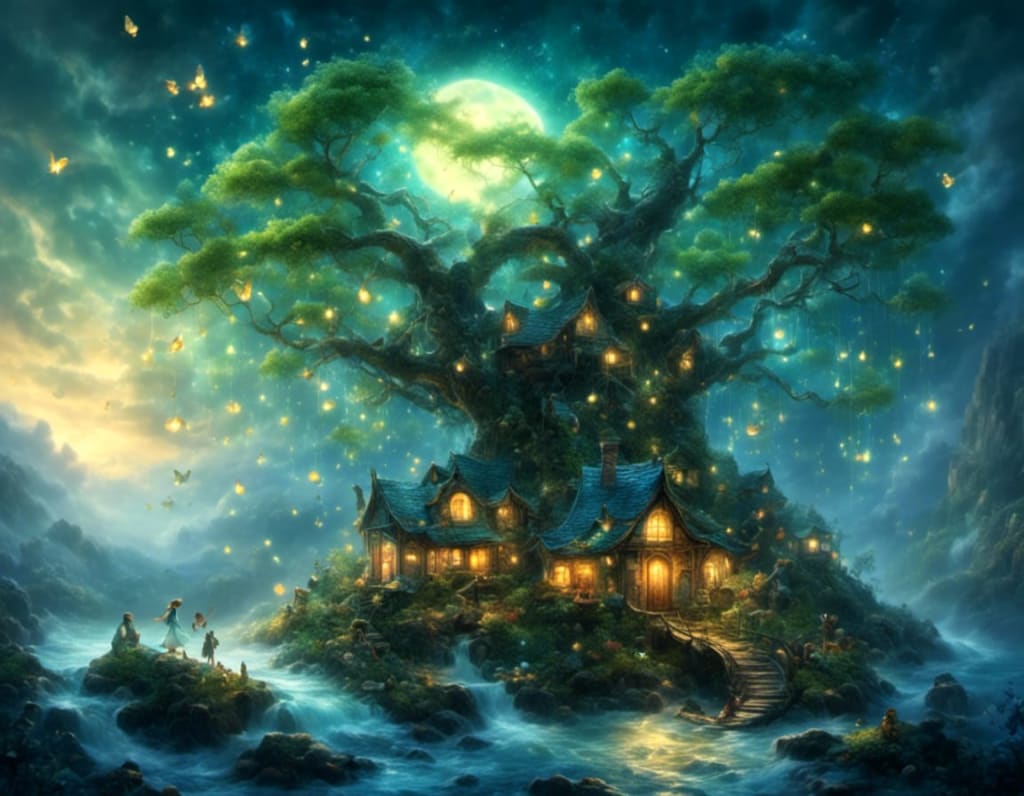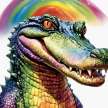Willow Cove Moon Dogs
a sister story to "Reunion of dragons"

Here in Willow Cove, there are so many amazing and bizarre creatures. On occasion, people from out of town flock to ooh and aah at the creatures. But our town was also dying, slowly growing abandoned since the creatures were starting to claim the town as their own. Hell, a lot of the creatures, like the star sharks, lava dogs and viper hounds were hostile to outsiders, chasing away tourists and thus a source of income. They never attacked the people of Willow Cove. So, that's good.
However, the loveliest of the creatures that resided here; not the sky whales, or cloud fish, not the hellcats, or puffcoons. They were called Moon Dogs.
No one knows when the Moon Dogs arrived, but they appeared around the same time as the other creatures. They were called Moon Dogs because each and every dog has fur the color of the moon.
People forget that the moon can also change color on occasion, so there are a few colors of Moon Dogs. Some Moon Dogs were a faint yellow, some were a dusty rose color, some were black as the new moon, a few red as an eclipse. But the most common color was a blue/grey.
Each moon dog held spots in the shape of moon craters, some had very faint spots, others cover a good majority of their bodies. But each and every Moon Dog was a beautiful creature to behold. To befriend. To own.
Through study, Willow Cove researchers found out several things about Moon Dogs.
A Moon Dog has a very diverse diet, from any type of fruits and vegetables to meats, to plastics and papers and metals. Hell, they even devoured stones and gravel. The average Moon Dog ate about 4 pounds of garbage a day, which is good since the average household creates four pounds of trash daily. Because of the intriguing diet, our local dump was not only being depleted, but several wild Moon Dogs created their dens there. I found this a good thing. Due to the diet, Moon Dog waste was an excellent fertilizer that helped local crops and even the foliage that surrounded Willow Cove.
When it came to Moon Dogs, the ethereal canines held distinctive gender dimorphism.
A male Moon Dog was large, very large. Standing up, a Male Moon dog was near the size of a small Shetland pony, with a large ruff of cloud like fur surrounding its neck, like a lion’s mane. A large block shaped head, similar to that of a Great Dane. Massive paws, one paw near the size of my head, and holding cloud like tufts around the ankles. On each toe there was a thick black claw, like a bear claw, that, despite its size, rarely made a noise on hard ground.
A female Moon Dog was smaller, standing only at the size of a St. Bernard, but slender. The female will have more distinct spots on their fur, but lacking a ruff, she will also have tufts of fur around her ankles as well. Her claws will not stand out like a male’s but rather retract like a cats. Her ears would be long and fluffy, like an Afghan. She will also have an arrow shaped head
Another distinction between Moon Dogs and regular dogs is that each and every Moon Dog has blank, reflective eyes. Like small mirrors instead of a pupil and iris. But they were expressive nonetheless.
Moon Dogs are also monogamous. Unless one of the pair dies, which I have never seen just yet, the pair stay together, raising cubs and defending food sources.
I got my Moon dog as a cub, the runt of a litter. Lugosi once used to fit in my coat pocket, where he resided his first three months of being my pet.
Baby Moon Dogs, called Star Cubs, were born with pitch black fur with faint blue freckles all over their tiny bodies. Star Cubs are also very small, so small you can cup a large one and it will fit in your hand. A litter of the cubs will contain up to thirty tiny bodies, all dependent on their mother. Star Cubs, right from birth, do not drink milk, but instead eat stardust.
Stardust is a soft dander-like powder that sheds from the mother’s sleek fur. It glistens a bit like glitter, but a Star Cub must feed on the stardust for three months before it can be separated from its mother.
Star Cubs also grow very slowly. My Lugosi only stood at my hip. He isn’t fully grown yet. Moon Dogs take up to 10 years to be full grown. But no one knows when a Moon Dog will die of old age. None have. The oldest Moon Dog we have in Willow Cove was 60 years old, belonging to an old woman, who found it as a Star Cub when she herself was a little girl.
But back to Lugosi.
My Moon dog was male, and his ruff was just starting to grow in. I only owned him for three years, so while he lost his black coat, his blue grey fur was spotty, still showing signs of cubhood.
Lugosi came from a litter owned by my brother, and the littlest cub was being bullied out of stardust. He was going to starve. So he gave him to me (so he thinks.)
It was hard, creating artificial stardust. But I found a substitute: black sand, and powdered oyster shell. Lugosi thrived on that dust for six long months. Afterward, I gave him rotted fruit and bits of gravel to ease him into the Moon Dog diet.
He is still small for his age, in the sense of Moon Dogs, but Lugosi has been by my side since. Being a male, my Lugosi has the ability to skywalk. He is still clumsy, but he is getting the hang of it.
Sky walking is a way that male Moon Dogs can run, leap, and glide through the air, the tufts on their legs becoming more gaseous, allowing flight. Females don't have this ability. Instead, they find their mate and allow the male to carry her either on his back, with the female’s head resting on the wisdom knot of the male, having her body limp as he carries her. Or, if the male is large enough, the female allows the male to carry her by her scruff. However, if there are Star Cubs, the female won’t leave them. So, the male stays to defend his mate. A female Moon Dog will defend her babies to the end of her life. If she dies, the male tends to the cubs until old enough to part ways. He will then look for another mate. If a male dies defending the female, the female will give out signals to tempt another male to protect her while she rears her cubs. Once the Star Cubs are grown, she will then part ways with the generous male, or mate with him.
Moon Dogs are a very interesting creature here at Willow Cove. We have a lot of tourists (those who can get past the more hostile creatures here) who coo and fawn over these gentle beasts. But another thing about Moon Dogs: they choose their human partner. You cannot just buy a Moon Dog. It must be a perfect match.
NO tourists ever left with a Moon Dog or Star Cub. They seem to prefer Willow Cove. They are loyal to Willow Cove residence. Salma knows what will happen if they bond with an outsider.
About the Creator
Enjoyed the story? Support the Creator.
Subscribe for free to receive all their stories in your feed. You could also pledge your support or give them a one-off tip, letting them know you appreciate their work.






Comments (1)
And now I want one... !